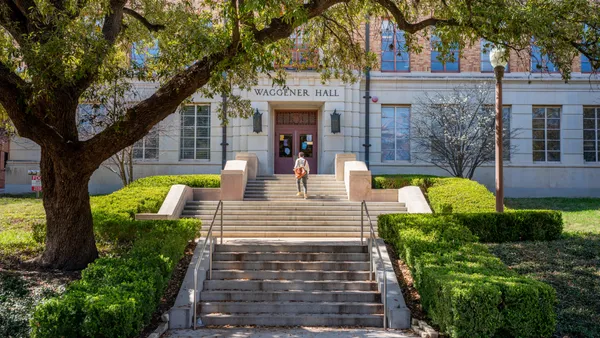Pushback against rising tuition, the stress of shrinking state funding and the possibilities afforded by advances in technology have higher ed leaders beginning to challenge some basic assumptions about their field. That process tends to be slow, however, and often makes for hubbub at trade conferences long before its effects can be seen.
But eventually the wheels get traction, and those given time with the mic do more than ideate possible solutions to well-documented problems. (Though one can argue that's an important step, too.) That was the case throughout this year's SXSW EDU, where higher ed leaders shared small but significant moves they are making toward broader change.
Education Dive was present last week in chillier-than-usual Austin, Texas, to learn about the tactics colleges, consortia and other industry groups are using to address some of the concerns around the accessibility and relevance of higher education in the 21st century.
Connect curriculum to jobs
With the economy hovering near full employment, employers can't be as picky as they could during and after the recession about the skill levels of the workers they hire. That's left them desiring better training and working on their own and with higher ed to get it.
Strada Education Network and Gallup found, according to research presented during one panel, that while only one-third of business leaders "strongly agree" college graduates are ready for the workforce, nine in 10 chief academic officers think their institutions are adequately preparing students.
With a growing focus on performance-based state funding and student outcomes, colleges want to be sure their graduates can find gainful employment. That's raising calls for colleges to bolster their career services offerings and more directly connect curriculum to skills required in related professions.
One example comes from Western Governors University, which works with employers to determine what hard and soft skills are needed among people employed in specific fields. The nonprofit online college, which uses a competency-based education model, then works with faculty to layer curriculum atop that map, said its provost and chief academic officer, Marni Baker Stein.
Knowing what skills are needed, and why, Western Governors can also segment offerings for its primarily adult learners. "If they have to leave us for a time and then come back and finish the degree later, we want to make sure they have something of value to take with them," she said.
Expand online strategically
Higher ed is getting more serious about serving adult learners, and one way is by adding online offerings. Doing so also creates a wider base over which an institution can spread costs for on-campus programs. That's an important consideration as the market becomes more sensitive to tuition increases.
"Any school giving an online program has sort of infinite capacity there," said John Katzman, founder of online program manager Noodle Partners and, before that, 2U. Although startup costs to bring a single classroom course online is "pretty steep" at around $75,000 plus about 100 hours of an instructor's time, he said, it "has tremendous benefit both in terms of quality and capacity."
Adult learners are squarely at the center of this strategy, as efforts underway by the State University of New York and the University of Massachusetts System indicate, but they can only generate so much demand.
"Growth is good, but growth is also limited," said Paul Friga, special advisor to the provost for online education at the University of North Carolina at Chapel Hill. He suggested the practice of using data to identify issues with current students and keep them from dropping as a way to lower both the institutions' replacement rate and therefore reduce costs.
Know your students' needs
It can be easy to reduce the image of college students to 18-to-22-year-olds on leafy campuses, attending classes full-time with a work-study job that pays for nights out. But higher ed leaders know better, or at least they should. About one-fifth of today's full-time students also work full-time, according to a report from Georgetown University's Center on Education and the Workforce. Meanwhile, the center notes, one-third of employed students are at least age 30, and about one-fifth of students who work also have children.
Those demographics have led to calls for colleges to offer more flexibility to meet students' range of responsibilities.
"What students bring onto campus and to their educational experience transcends what higher ed is and can do," said Julie Peller, executive director at Higher Learning Advocates. "We often think about students as a student, and that's it. … That student today is juggling transportation issues, parenting and childcare issues ... and their work schedule along with their classes."
What's more, college students are disqualified from some key social services, said Peller, and may not realize they are eligible for others. A report released earlier this year from the U.S. Government Accountability Office found one in three college students lacks adequate access to food and 1.8 million students who could qualify for SNAP don't participate.
Issues affecting low-income students can snowball, said James Kvaal, president of The Institute for College Access and Success (TICAS). Not being able to pay for gas for their car can cause a student to miss work, losing their job and the income to afford housing, he gave as one example.
"We need to keep in mind when we say a student can work part-time, that student is (often) in the same low-wage workforce that suffers all kinds of instability and job quality problems," he said, adding that students may also have expenses financial aid doesn't consider, such as costs associated with supporting a family.
In a recent policy paper, TICAS noted that such unmet need could cause students to work longer hours and take a lighter course load, "both of which compromise their graduation prospects."
Dig into data
Another way to improve students' potential outcomes is to keep a closer eye on them by using data to predict whether they might need additional support.
Georgia State University was an early leader in using predictive analytics to improve student outcomes. The university's senior vice president for student success, Timothy Renick, explained during a panel on the topic that it tracks around 800 risk factors each day that could cause a student to drop out. For example, WiFi and LMS log-ins on campus as a proxy for class attendance. "We look at individual patterns, and if there's a drop-off, we use that as an early alert," he said.
The analytics also let administrators know about one-third of students who take the university's introductory accounting course struggle early in the semester.
"Because we have the understanding, it has changed the way we approach the issue in some substantive ways," Renick said, adding that the information is shared with accounting faculty as well. "It has also required us to be creative in creating new supports for students. If a student comes in three weeks into the semester struggling with accounting, you can't send them to the math lab." Instead, the university has developed a peer tutor program through which students who have previously succeeded in a class help those who are struggling.
The University of Texas at Austin implemented its predictive analytics around the same time with the goal of increasing its four-year graduation rate to 70%, said Carolyn Connerat, associate vice provost for enrollment management. It effectively accomplished that goal in 2018, due in part to its diligent tracking of students based on factors that historical data determined would cause them to not graduate within four years.
"(For) the students who were less likely to graduate in four years, we made sure every single one of them had a support program, a community, a success program that ... would help them to be able to succeed," she said.
To figure out what behaviors and scenarios to track, UT Austin used its trove of admissions data. "That's going to be the question for everyone: What data do you have that you can get your hands on so you can then figure out what are those questions you want to ask?" Connerat said.
She recommends a starting point in looking at incoming freshmen and the move from the first to the second semester and from freshman to sophomore year. Faculty may be inconsistently reporting grades and other performance indicators, she said. Working with the registrar's office, however, can help track students' progress toward a degree.
"Predictive analytics is just a tool," she said. "What are you going to do with it is the key and being able to figure out ... how are you going to use this to really to help your students."
Get buy-in on mission
"You could've heard a pin drop," said Patrick Awuah Jr. (top image), president of Ashesi University about the moment he told faculty members he suspected students were frequently cheating. When Awuah, a SXSW EDU keynote speaker, opened Ashesi in Ghana in 2002, relatively few people there went to college, he said. That meant what was happening at those institutions was very important to the future of the country, which itself was experiencing a crisis of leadership.
Ashesi's mission "to educate a new generation of ethical, entrepreneurial leaders in Africa" ran counter to the notion of cheating.
So he called out the students and invited them into a conversation about what kind of society they wanted for Africa, Ghana and their own campus. "I don't want to be the keeper of this mission," he told them. "You must be the keepers of this mission." Perhaps most compellingly, he told the institution's major donors about the students' behavior. "That transparency … motivated us, compelled us to really act," he said.
In response, students created an honor system through which they agreed not to tolerate unethical behavior on their campus.
More than half of the global population growth through 2050 is expected to occur on the African continent. And addressing the corresponding demand for education will not be the job of only one institution, he said.
"We are responsible for educating leaders who are ethical, who care, who are compassionate and who have the capability to solve problems, and who have the expectation that problems will be solved and who have the curiosity and foresight to identify opportunities and innovate," he said.





















